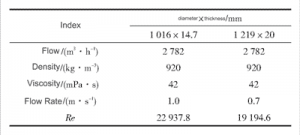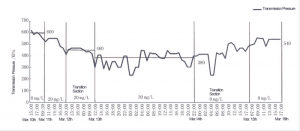Abstract:
More oil fields use drag reducing agents in oil pipelines. Increase the transmission of crude oil pipeline by injecting drag-reducing agents. This is due to the rapid development of technology for pipelines to reduce drag and increase transmission. This can meet the needs of increasing output in a short time. And it will not increase the investment cost. The production capacity of an oil field in the Middle East is restricted by oil pipelines. It is planned to reduce the external pressure by adopting the method of injecting drag-reducing agents to the oil pipeline. This requires scene testing in the field. To test the Drag reducing agent in this way. The premise is to first determine whether the flow state of the fluid meets the applicable range of the drag reducer. To calculate the dispersion time of the DRA. Accurately determine the injection point of the drag-reducing agent. Finally, it is concluded that when the dosage of the drag-reducing agent is 20mg/L, the drag reduction rate of station No.1 is 23%. The drag reduction effect is obvious. The three stations can deliver 56340 tons of crude oil per day. You can save 7962 kWh. From this point of view, the method of using drag-reducing agents in oil pipelines can effectively reduce drag and increase transportation. And can avoid one-time high investment. Compared with other methods, the method of injecting the drag reducing agent into the oil pipeline has the following advantages. Low investment, easy to realize, flexible operation, and good economic benefit.
1.Current Situation.
Oilfield production companies generally use external pumps and pipelines to transport crude oil. With the increase in production and corrosion of pipelines, the characteristics of pipeline systems have changed. This causes the external pump to fail to deliver crude oil timely according to the rated volume. At present, the application of drag-reducing agents in oil pipelines is developing rapidly. In oilfield production, the injection of drag reducers is used to reduce pressure drop losses and increase pipeline output.
There are 3 crude oil processing stations in an oil field in the Middle East. The distance between stations is 7 km. 1# site is in the main production block. Station 3# is closest to the final station. The crude oil is transported to the final station via an external pipeline. This external pipeline is an old pipeline with a total length of 57 km. The pipeline lines are aging and there is no facility to clean. Increased friction in the piping system. When the output of crude oil increases, the external pump cannot deliver crude oil in time. This caused the liquid level of the crude oil storage tank to continue to rise.
In addition, the pipeline is buried underground. Because there is no cathodic protection system and external anti-corrosion layer, the external corrosion of the pipeline is severe, and leakage often occurs. The storage capacity of the station is limited. When an accident occurs in an external pipeline, the production can only be shut down. When resuming production, it is necessary to increase the output to ensure the completion of production tasks.
When the additional transmission is needed, the following problems will occur on the spot. When the 3# station and the 2# station deliver oil at full load at the same time. The backpressure of station 1# is too high to deliver the produced crude oil in time. When the winter comes, the viscosity of crude oil will increases. The problem of external transmission in 1# station is more severe. Since the new pipeline is under construction, it will take at least 3 years to put it into production. In this case, the production department decided to use the method of injecting drag reducing agent to solve the problem of the 1# station.
According to the information provided by the drag reducing agent manufacturers, there has been an example of using drag reducers in this area, and the effect is very good. Based on this situation, our company decided to draw on the experience of drag-reducing agent applications from other oil fields. No more screening and indoor evaluation of drag-reducing agents. We are ready to conduct a direct field test to evaluate the dosage and effectiveness of the DRA and guide the production based on the results of the experiments.
2. Experiment plan
2.1 Test conditions
See Table 1 for the nature of crude oil.
Test pipe section: 57km pipeline from station 1# to the final station. The elevation difference of the pipeline is minus three meters (-3m). Basic conditions: The total average flow rate of the three stations is 56340 tons per day. See Table 2 for the calculation of the flow velocity and Re of each pipe section (6000<Re<1000000).
2.2 Injection process
The drag-reducing agent is a white slurry liquid with a closed flashpoint of 62.8 ℃ and a relative density of 0.86 (20 ℃). The injection point is between the 1# station the metering skid and the external pipeline enters the ground. This can avoid the shear of the external pump impeller and the flow meter’s interception and stirring action. And the drag reducing agent has enough distance to meet the requirements of dispersion time. The DRA injection skid includes injection pumps, flow meters, and pressure gauges. The pneumatic chemical agent injection pump is used to introduce the instrument wind as the power source. The pressure is 345 to 1,034 kPa and the flow rate is 419 L/min. According to the recommendations provided by the drag-reducing manufacturers, the test dosage is 20 mg/L and 30 mg/L.
3. Test process and results
Read the external pressure at the corresponding time of the day from the pressure curve of the handover gauge. The time interval is about one hour. When the total average flow rate does not change, to add DRA from station 1#. According to the flow velocity calculation, it takes about 24 hours for the drag reducing agent to cover the whole line, which is called the transition period. The experiment was conducted for 6 days. And the pressure of each station before and after dosing was recorded.
The pressure value was read from the pressure curve of the transfer gauge every one hour while keeping the total average flow rate unchanged. When the dosages are 20 mg/L and 30 mg/L, to monitor the pressure changes of each station. And ensure at least 24 hours of continuous injection time for each dose to obtain the best effect. So as to evaluate the DRA. During the test, the entire pipeline throughput was controlled at about 56340t/d. And the pressures of stations 1#, 2#, and 3# were recorded and analyzed respectively. Taking station 1# as an example, the collected pressure value of the transfer meter is first processed for data, excluding normal or unstable data, reading reasonable data, and drawing a pressure curve (Figure 2).
As can be seen from Figure 3, from 09:30 on March 11 to 10:00 on March 12. After adding the DRA for 24h, the DRA started to work and the pressure gradually decreased. Do not analyze the transition data in the test results. Take the average value of pressure and record the pressure at the same dose under the same dosage. From 10:00 on March 12 to 12:00 on March 13, when the continuous dose was 20 mg/L, the average pressure of the external delivery decreased to 460 kPa. From 12:00 on March 13 to 22:00 on March 15, after the dosage was increased to 30mg/L, the outbound pressure decreased to 380kPa. After stopping the dosing for 24 h, the pressure rose back to 540 kPa. Record the outgoing pressure at each station. Use the average pressure to calculate the drag reduction rate with the same dosing amount. The results are shown in Table 3.
It can be seen from Table 3 that when the total flow of transportation changes little, 1# station is the furthest away from the final station and has the best drag reduction effect. When the dosage is 20 mg/L, the drag reduction rate at station 1# is 23%. When the dosage is 30 mg/L, the drag reduction rate is 37%. Compared with the increase in drag reduction rate, when the dosage is 20 mg/L, the drag reduction rate is 23%. When the dosage is 30 mg/L, it is only 17%.
Although the increase in the dosage of 10 mg/L can increase the drag reduction rate, the increase was limited. The effect on station 2# and station 3# is even less obvious. Therefore, when the dosage is 20 mg/L, the reduction of the pipeline back pressure can meet the maximum delivery of the external delivery pump. The effect is obvious. And it is more economical. Using 20 mg/L as the basic dosage in production can meet the requirements. According to the test results, when the dosage is 20 mg/L, the three stations deliver 56340 tons of crude oil per day, which can save 7962 kWh.
5. Conclusion
According to the test results, IRO drag reducing agent has an obvious effect on the drag reduction of oil field crude oil. When the dosage is 20 mg/L, the drag reduction effect is significant. Therefore, the recommended basic dosage for production is 20 mg/L. According to the change of the flow rate, the change of gas temperature in different seasons, and the characteristics of the pipeline, the IRO drag reducing agent is added to the oil pipeline in the oil field. To meet the requirements of drag reduction and an increase in transmission.










